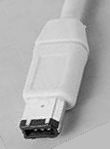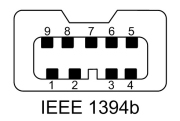IEEE 1394 ("FireWire")
IEEE 1394a
The IEEE 1394 high-speed serial bus is designed for the exchange of information between
PCs and consumer electronics devices that transfer large amounts of data. It is a multimedia bus enabling high-speed peripherals, convergence between PCs, peripherals and consumer A/V products and enabling new applications for traditional products. This bus is also named FireWire by Apple or i.Link by Sony.
It was developed by APPLE COMPUTER, INC. and TEXAS INSTRUMENT and is approved by the Institute of Electrical and Electronics Engineers, supported by the Consumer Electronics Association and many consumer electronics manufacturers.
IEEEn1394a:
It is a serial bus similar in principle to USB and the transfer speeds are 100 Mbit/s, 200 Mbit/s
and 400 Mbit/s.
IEEEn1394b:
This is the newer version with a transfer speed of 800 Mbit/s.
With 1394, there is plenty of bandwidth for several high-speed devices to work at the same time.
IEEE 1394 is a truly universal I/O connection. It has a scalable architecture and flexible peer-to-peer topology.
With the peer-to-peer capabilities, peripherals can connect directly to each other
such as a scanner and a printer for "photocopies" or a digital camera and a photo-quality
printer. 1394 also enables new applications for traditional devices such as mass storage
connected directly to an STB. The 1394 is also hot pluggable - users can add or remove 1394 devices with the bus active.
The cable TV industry has also adopted the IEEE 1394 for connecting set-top boxes to high-definition TV sets.
IEEE 1394 has its own copy protection protocol DTCP or '5C'.
Faster versions of the bus are under development with serial data rates of over 3 Gbps.
 | |
 |
| 1394 connector pinout, 4-pin and 6-pin | |
1394 connector, 6-pin |
| IEEE 1394a 4-pin | IEEE 1394a 6-pin |
| Pin | Signal | Pin | Signal |
| | | 1 | Power |
| | | 2 | Ground |
| 1 | TPB- | 3 | TPB- |
| 2 | TPB+ | 4 | TPB+ |
| 3 | TPA- | 5 | TPA- |
| 4 | TPA+ | 6 | TPA+ |
1394 involves the low three ISO protocol layers: the Physical Layer, the Link Layer, and the Transaction
Layer. The Serial Bus Management process connects all three layers.
The Physical Layer provides the electrical and mechanical connection, the Link Layer provides data
packet delivery service, the Transaction Layer supports the asynchronous protocol write, read, and lock commands.
The data transport is isochronous. The sender requests an isochronous channel with a specific bandwidth and the
isochronous channel IDs are transmitted followed by the packet data. The receiver monitors the incoming
data's channel ID and accepts only data with the specified ID.
The IEEE 1394 cable contains two power conductors, and two twisted pairs for data transfer.
Each data pair is shielded and the entire cable is shielded too. Power on the two power conductors is specified to
be from 8Vdc to 40Vdc at up to 1.5 amps and is used to maintain the device's physical layer
continuity when the device is powered down or malfunctioned and provide power for devices connected to the bus.
The connectors are derived from the Nintendo GameBoy(tm) connectors. They are field tested, small, flexible and very durable.
Devices can have multiple connectors to allow daisy-chain and tree topologies.
IEEE 1394b
 |
| Pin | Signal |
| 1 | TPB- |
| 2 | TPB+ |
| 3 | TPA- |
| 4 | TPA+ |
| 5 | A Shield |
| 6 | Ground |
| 7 | n/c |
| 8 | Power |
| 9 | B Shield |
|





